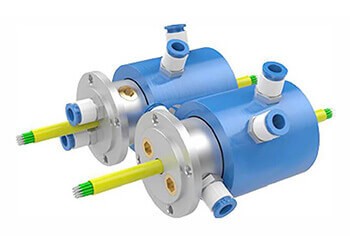In a significant breakthrough for industries requiring continuous power and data transmission between rotating and stationary components, a cutting-edge invention has emerged: the rotating slip ring connector. Designed to overcome the limitations of traditional connectors, this groundbreaking technology promises to revolutionize a wide range of sectors, from aerospace and manufacturing to robotics and wind energy. In this article, we will explore the features, applications, and potential implications of this curious new device.
Unveiling the Rotating Slip Ring Connector
Breaking the shackles of conventional connectors, the rotating slip ring connector offers an elegant solution to the longstanding challenge of maintaining seamless power and data transmission in rotating systems. Unlike standard connectors that rely on cables that can become entangled or damaged during rotation, slip ring connectors use a combination of rings and brushes to enable uninterrupted transfer of electrical signals and other data across rotating and stationary components.
How It Works
At the heart of the rotating slip ring connector lies a precision-engineered mechanism that enables continuous electrical contact despite rotation. The connector consists of two main parts: a stationary component and a rotating component. The stationary component is fixed to the non-rotating part of the system, while the rotating component is attached to the rotating element.
The rotating slip ring connector employs a set of conductive rings that make electrical contact with brushes mounted on the rotating part. These rings rotate with the system, maintaining a seamless connection throughout the rotation. This ingenious design ensures that power, signals, and data can be transmitted without interruption or interference, enabling efficient operation and control of rotating machinery.
Applications across Industries
The potential applications of rotating slip ring connectors are vast and diverse, with industries around the world poised to benefit from this transformative technology. Let’s explore some of the key sectors where these connectors are set to make a significant impact:
Aerospace: In the aerospace industry, rotating slip ring connectors are poised to enhance the performance and reliability of various systems, such as radar antennas, satellite communication systems, and aircraft engine instrumentation. These connectors provide the necessary interface for transmitting power and signals to rotating components like radar arrays or swiveling antennas, enabling seamless communication and data transmission.
Manufacturing and Robotics: Industrial automation and robotics heavily rely on rotating components for precision motion and control. The introduction of slip ring connectors eliminates the need for cumbersome and delicate cables, thereby improving the overall reliability and efficiency of robotic systems. This technology facilitates the smooth transfer of power and data between rotating robotic arms and their stationary controllers, opening doors to enhanced productivity and streamlined manufacturing processes.
Wind Energy: Wind turbines are subject to continuous rotation, and the transfer of power and data from the rotating blades to the stationary base has always been a challenge. Rotating slip ring connectors offer a reliable and durable solution by ensuring uninterrupted transmission of electrical signals, allowing for efficient power generation and control in wind energy systems.
Medical Equipment: Rotating slip ring connectors have the potential to transform the medical field, particularly in applications such as MRI scanners and robotic-assisted surgery. These connectors enable precise and continuous transmission of power and data, ensuring seamless imaging and precise control of robotic surgical instruments.
Implications and Future Prospects
The advent of rotating slip ring connectors has far-reaching implications for a multitude of industries. By providing a robust and efficient means of power and data transmission in rotating systems, these connectors can significantly enhance the reliability, performance, and safety of numerous applications. Moreover, the elimination of traditional cables and their associated drawbacks, such as entanglement and wear, can result in cost savings and reduced maintenance requirements.
Looking ahead, researchers and engineers are actively working to further advance the capabilities of rotating slip ring connectors. Efforts are underway to increase data transfer rates, improve durability, reduce size, and enhance compatibility with various operating conditions. With continued advancements in this field, we can anticipate even broader adoption of slip ring technology and its integration into novel and cutting-edge applications.
The emergence of the rotating slip ring connector marks a turning point in the world of power and data transmission across rotating systems. Its innovative design and seamless functionality have the potential to revolutionize a wide range of industries, from aerospace and manufacturing to renewable energy and medical technology. As this transformative technology continues to evolve, we can expect to witness enhanced efficiency, increased reliability, and unprecedented possibilities in various sectors. The future is indeed bright for the rotating slip ring connector, unlocking new realms of seamless connectivity in the dynamic world of rotating machinery.
See What We Can Do

